Communication in Health and social care Assignment
VerifiedAdded on 2021/05/31
|13
|888
|124
Presentation
AI Summary
Contribute Materials
Your contribution can guide someone’s learning journey. Share your
documents today.
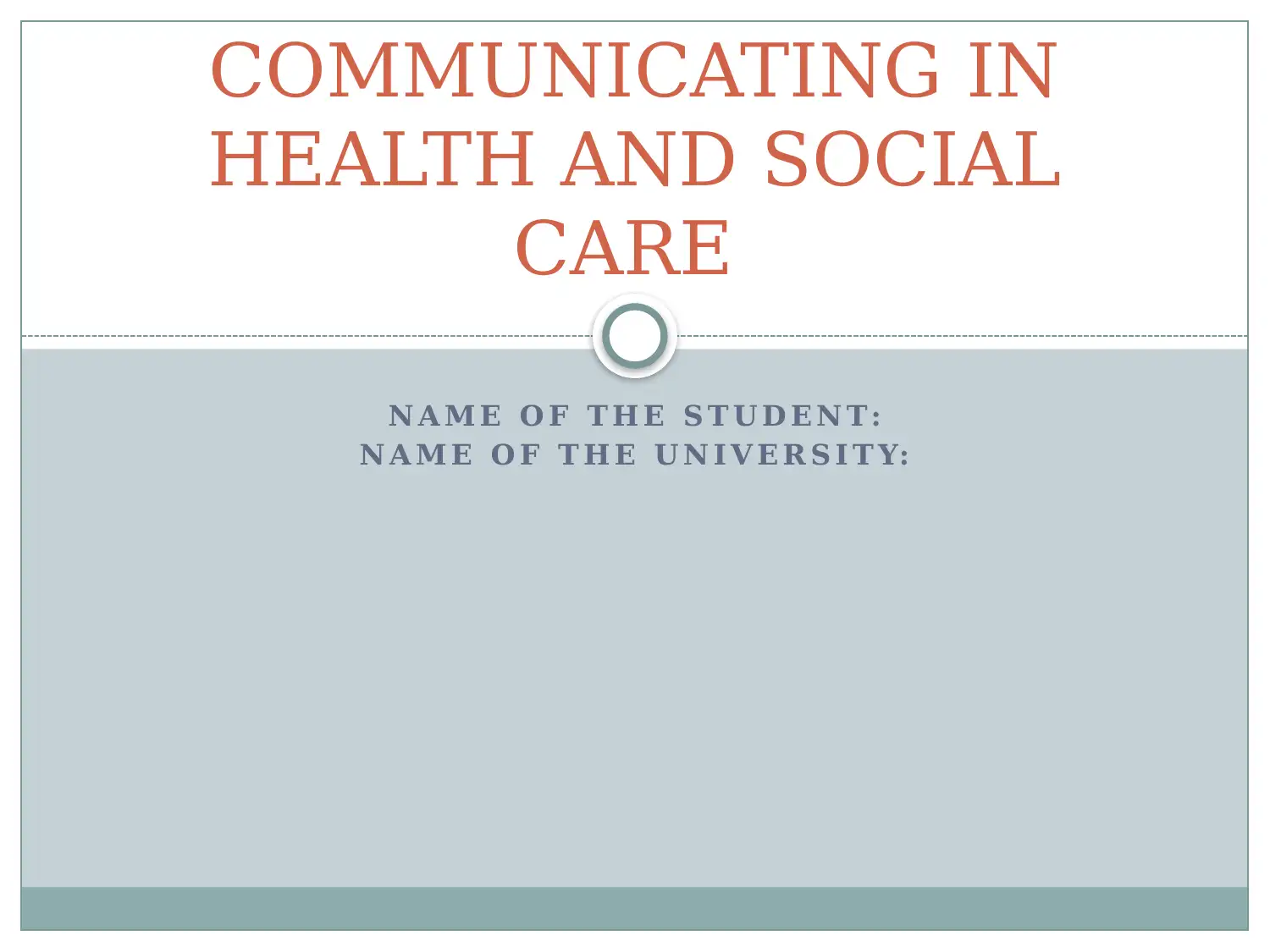
N A M E O F T H E S T U D E N T :
N A M E O F T H E U N I V E R S I T Y:
COMMUNICATING IN
HEALTH AND SOCIAL
CARE
N A M E O F T H E U N I V E R S I T Y:
COMMUNICATING IN
HEALTH AND SOCIAL
CARE
Secure Best Marks with AI Grader
Need help grading? Try our AI Grader for instant feedback on your assignments.
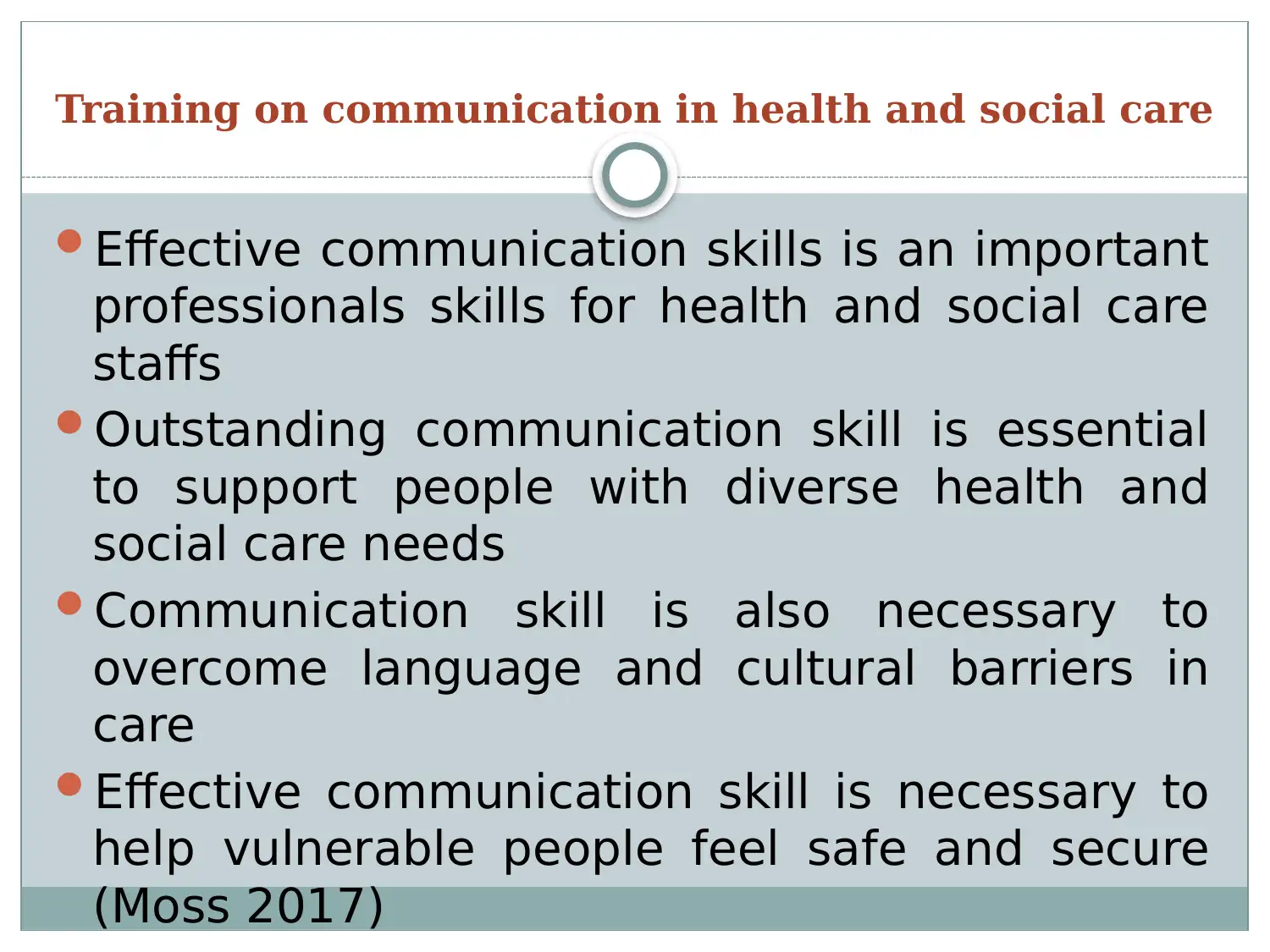
Training on communication in health and social care
Effective communication skills is an important
professionals skills for health and social care
staffs
Outstanding communication skill is essential
to support people with diverse health and
social care needs
Communication skill is also necessary to
overcome language and cultural barriers in
care
Effective communication skill is necessary to
help vulnerable people feel safe and secure
(Moss 2017)
Effective communication skills is an important
professionals skills for health and social care
staffs
Outstanding communication skill is essential
to support people with diverse health and
social care needs
Communication skill is also necessary to
overcome language and cultural barriers in
care
Effective communication skill is necessary to
help vulnerable people feel safe and secure
(Moss 2017)
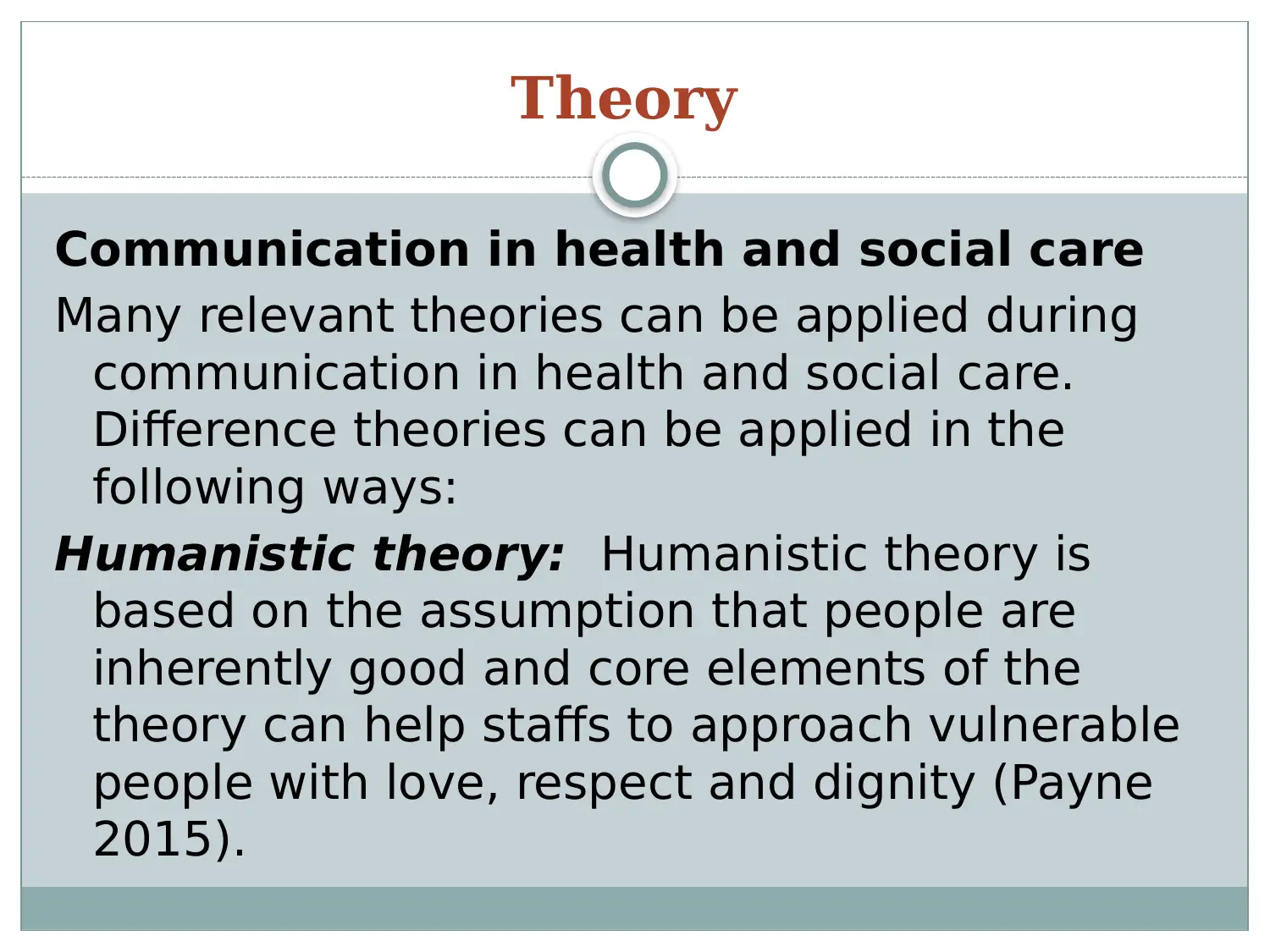
Theory
Communication in health and social care
Many relevant theories can be applied during
communication in health and social care.
Difference theories can be applied in the
following ways:
Humanistic theory: Humanistic theory is
based on the assumption that people are
inherently good and core elements of the
theory can help staffs to approach vulnerable
people with love, respect and dignity (Payne
2015).
Communication in health and social care
Many relevant theories can be applied during
communication in health and social care.
Difference theories can be applied in the
following ways:
Humanistic theory: Humanistic theory is
based on the assumption that people are
inherently good and core elements of the
theory can help staffs to approach vulnerable
people with love, respect and dignity (Payne
2015).
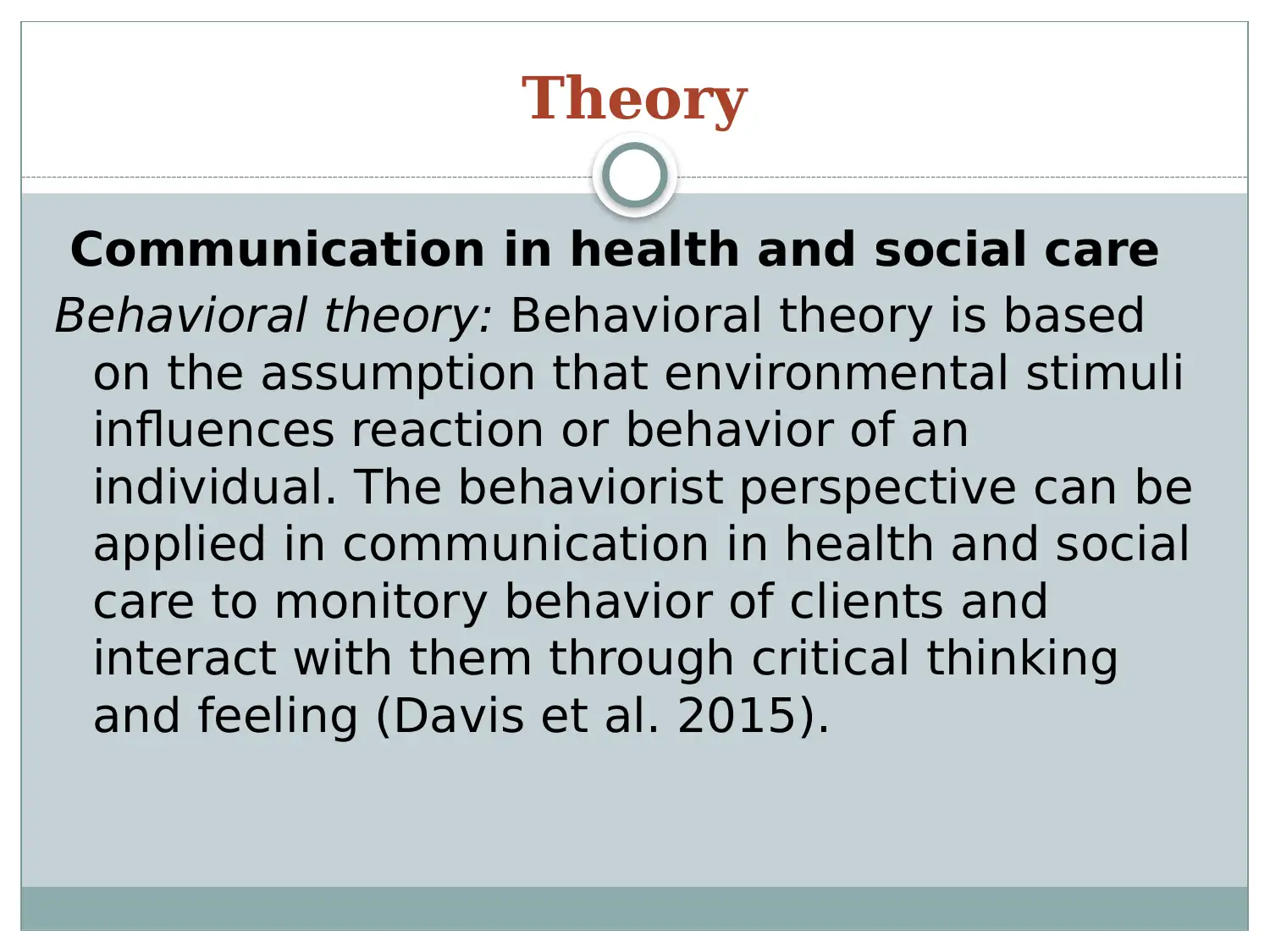
Theory
Communication in health and social care
Behavioral theory: Behavioral theory is based
on the assumption that environmental stimuli
influences reaction or behavior of an
individual. The behaviorist perspective can be
applied in communication in health and social
care to monitory behavior of clients and
interact with them through critical thinking
and feeling (Davis et al. 2015).
Communication in health and social care
Behavioral theory: Behavioral theory is based
on the assumption that environmental stimuli
influences reaction or behavior of an
individual. The behaviorist perspective can be
applied in communication in health and social
care to monitory behavior of clients and
interact with them through critical thinking
and feeling (Davis et al. 2015).
Secure Best Marks with AI Grader
Need help grading? Try our AI Grader for instant feedback on your assignments.
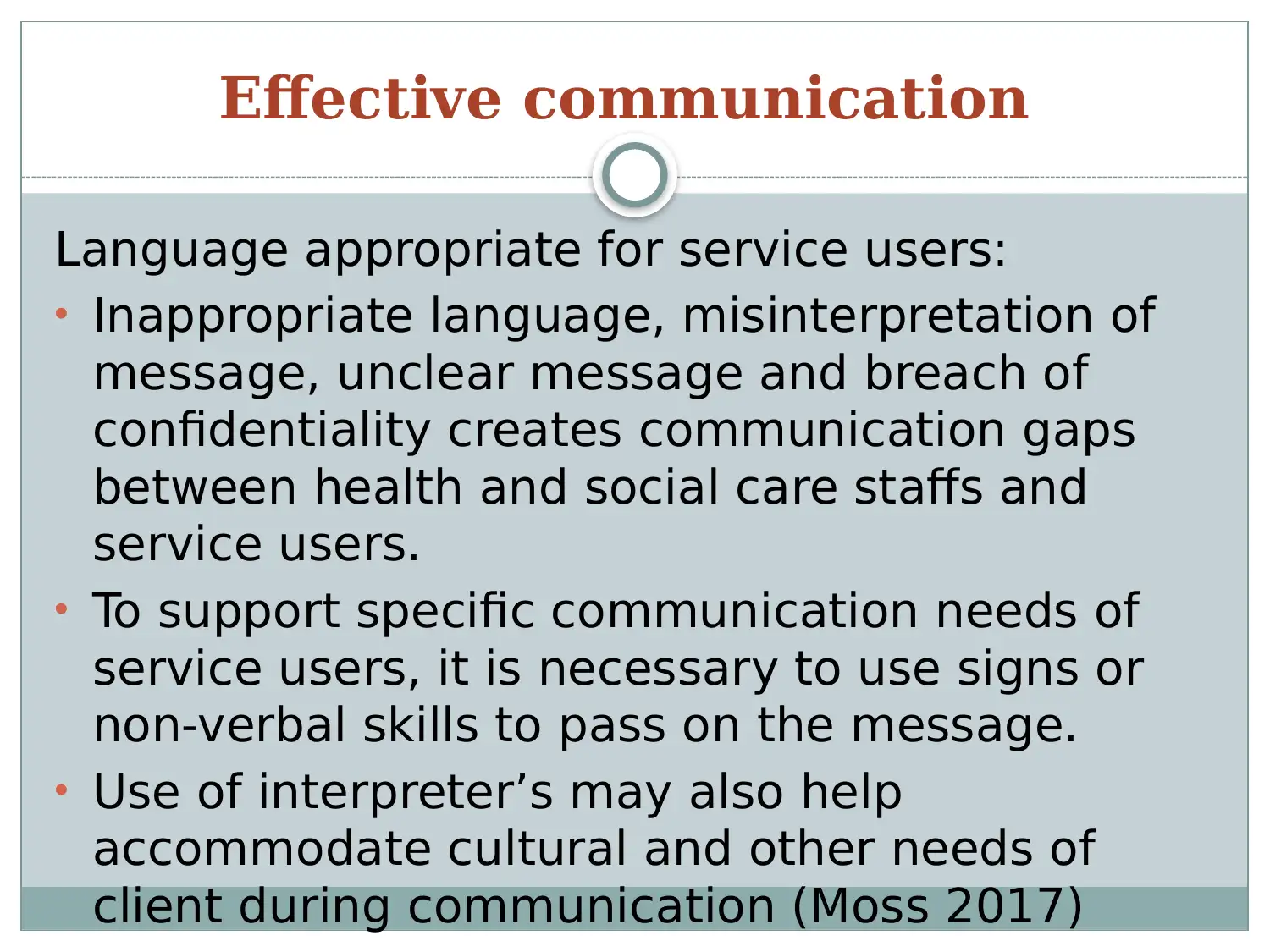
Effective communication
Language appropriate for service users:
• Inappropriate language, misinterpretation of
message, unclear message and breach of
confidentiality creates communication gaps
between health and social care staffs and
service users.
• To support specific communication needs of
service users, it is necessary to use signs or
non-verbal skills to pass on the message.
• Use of interpreter’s may also help
accommodate cultural and other needs of
client during communication (Moss 2017)
Language appropriate for service users:
• Inappropriate language, misinterpretation of
message, unclear message and breach of
confidentiality creates communication gaps
between health and social care staffs and
service users.
• To support specific communication needs of
service users, it is necessary to use signs or
non-verbal skills to pass on the message.
• Use of interpreter’s may also help
accommodate cultural and other needs of
client during communication (Moss 2017)
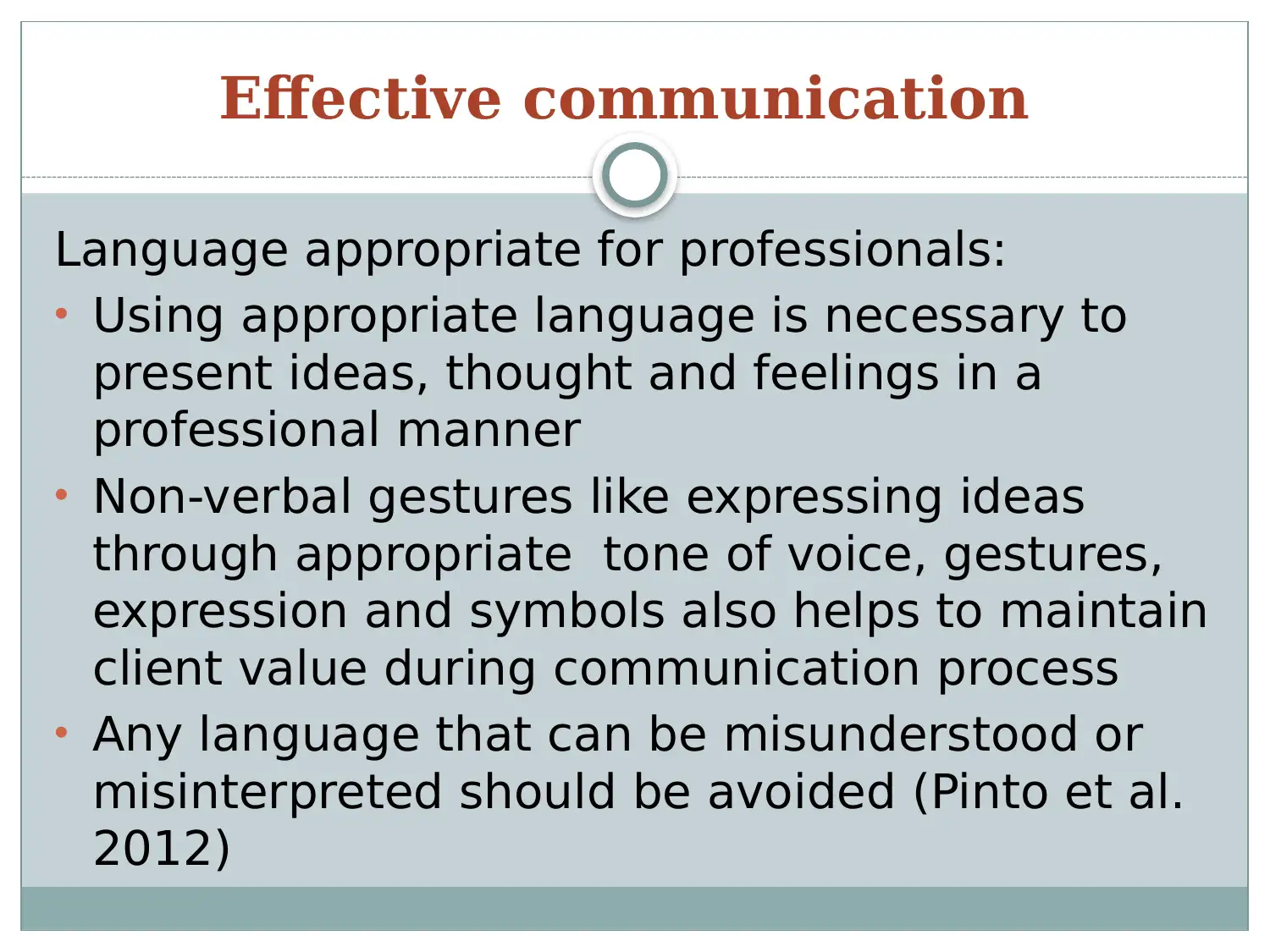
Effective communication
Language appropriate for professionals:
• Using appropriate language is necessary to
present ideas, thought and feelings in a
professional manner
• Non-verbal gestures like expressing ideas
through appropriate tone of voice, gestures,
expression and symbols also helps to maintain
client value during communication process
• Any language that can be misunderstood or
misinterpreted should be avoided (Pinto et al.
2012)
Language appropriate for professionals:
• Using appropriate language is necessary to
present ideas, thought and feelings in a
professional manner
• Non-verbal gestures like expressing ideas
through appropriate tone of voice, gestures,
expression and symbols also helps to maintain
client value during communication process
• Any language that can be misunderstood or
misinterpreted should be avoided (Pinto et al.
2012)
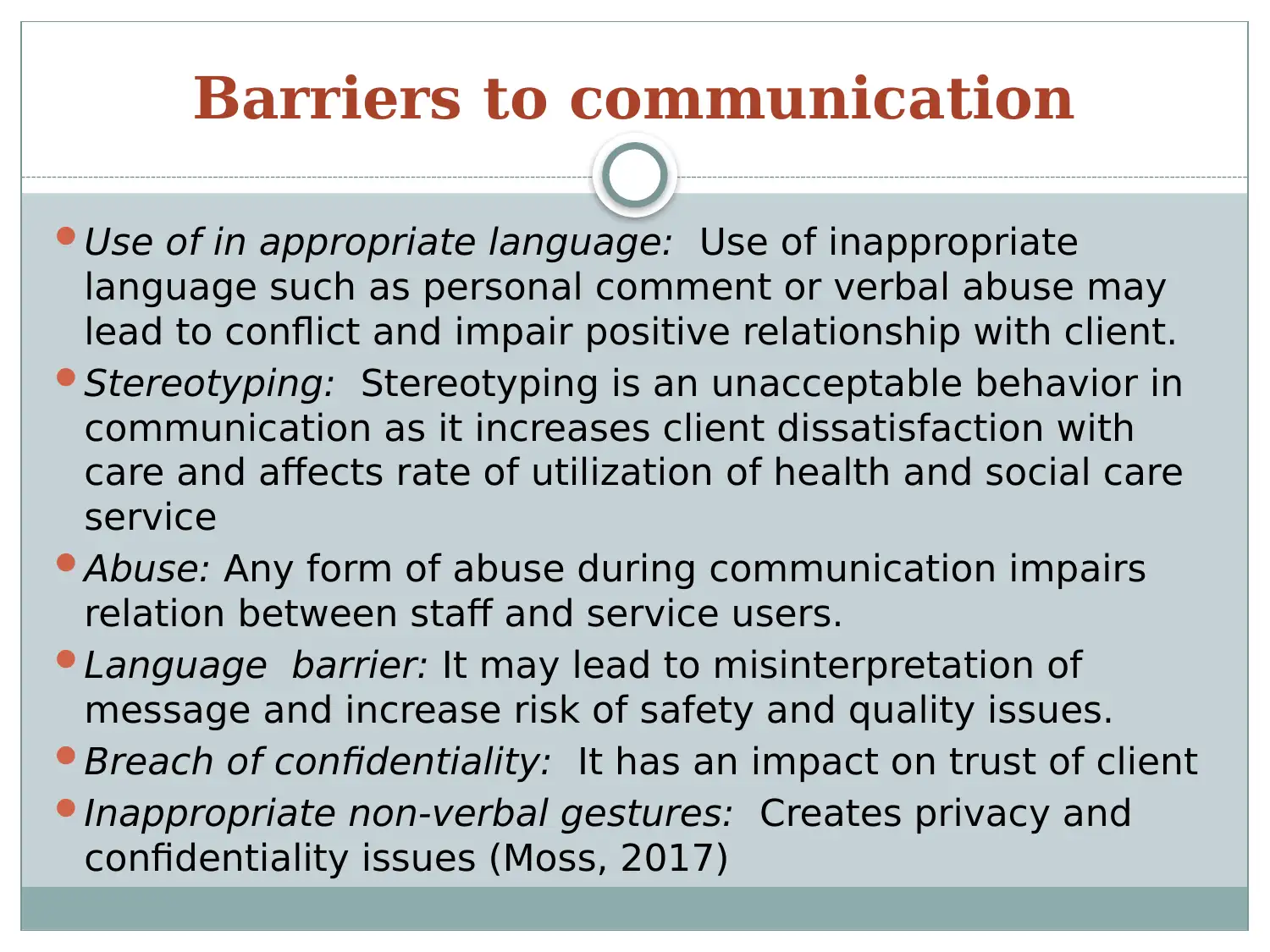
Barriers to communication
Use of in appropriate language: Use of inappropriate
language such as personal comment or verbal abuse may
lead to conflict and impair positive relationship with client.
Stereotyping: Stereotyping is an unacceptable behavior in
communication as it increases client dissatisfaction with
care and affects rate of utilization of health and social care
service
Abuse: Any form of abuse during communication impairs
relation between staff and service users.
Language barrier: It may lead to misinterpretation of
message and increase risk of safety and quality issues.
Breach of confidentiality: It has an impact on trust of client
Inappropriate non-verbal gestures: Creates privacy and
confidentiality issues (Moss, 2017)
Use of in appropriate language: Use of inappropriate
language such as personal comment or verbal abuse may
lead to conflict and impair positive relationship with client.
Stereotyping: Stereotyping is an unacceptable behavior in
communication as it increases client dissatisfaction with
care and affects rate of utilization of health and social care
service
Abuse: Any form of abuse during communication impairs
relation between staff and service users.
Language barrier: It may lead to misinterpretation of
message and increase risk of safety and quality issues.
Breach of confidentiality: It has an impact on trust of client
Inappropriate non-verbal gestures: Creates privacy and
confidentiality issues (Moss, 2017)
Paraphrase This Document
Need a fresh take? Get an instant paraphrase of this document with our AI Paraphraser
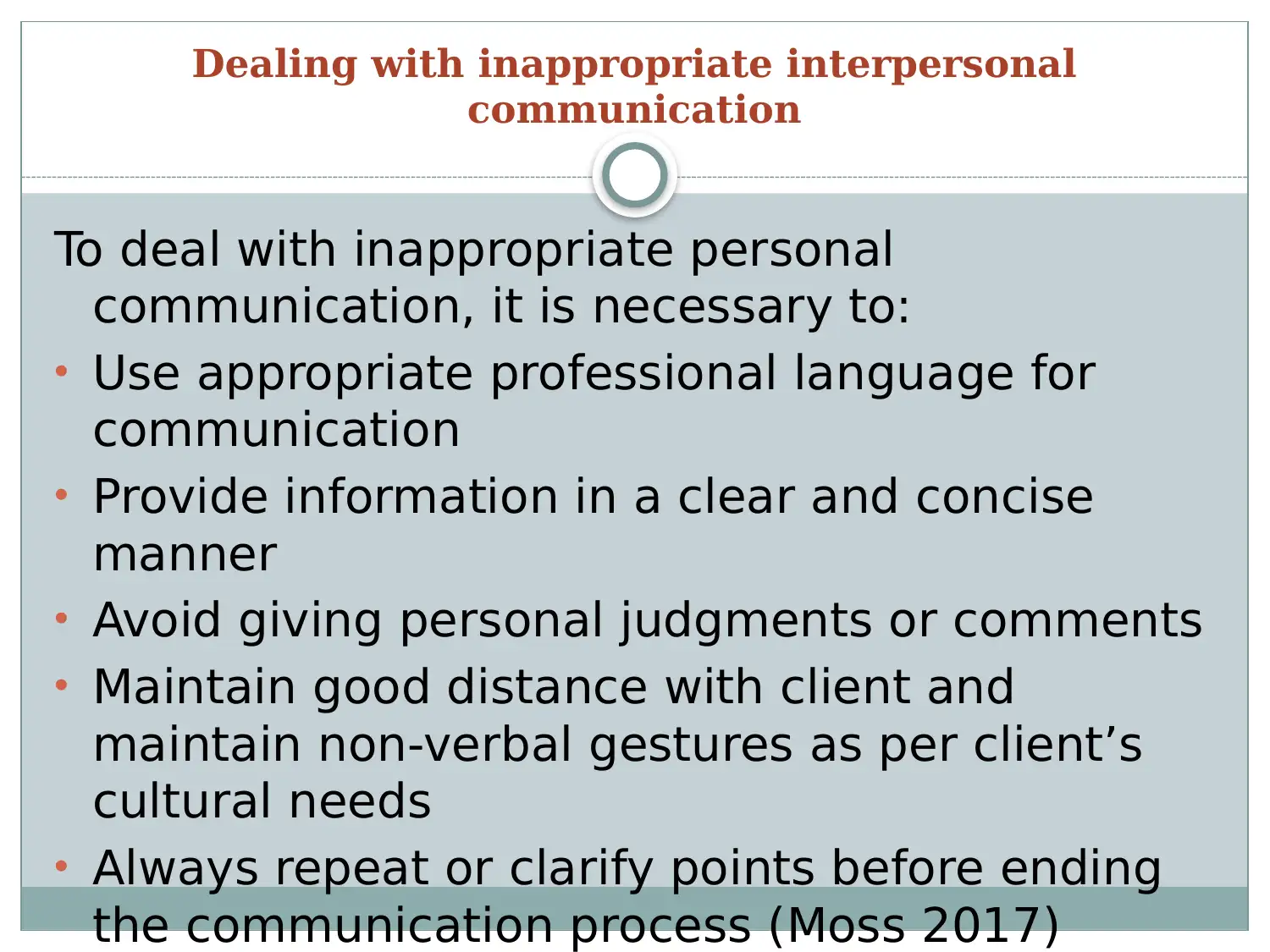
Dealing with inappropriate interpersonal
communication
To deal with inappropriate personal
communication, it is necessary to:
• Use appropriate professional language for
communication
• Provide information in a clear and concise
manner
• Avoid giving personal judgments or comments
• Maintain good distance with client and
maintain non-verbal gestures as per client’s
cultural needs
• Always repeat or clarify points before ending
the communication process (Moss 2017)
communication
To deal with inappropriate personal
communication, it is necessary to:
• Use appropriate professional language for
communication
• Provide information in a clear and concise
manner
• Avoid giving personal judgments or comments
• Maintain good distance with client and
maintain non-verbal gestures as per client’s
cultural needs
• Always repeat or clarify points before ending
the communication process (Moss 2017)
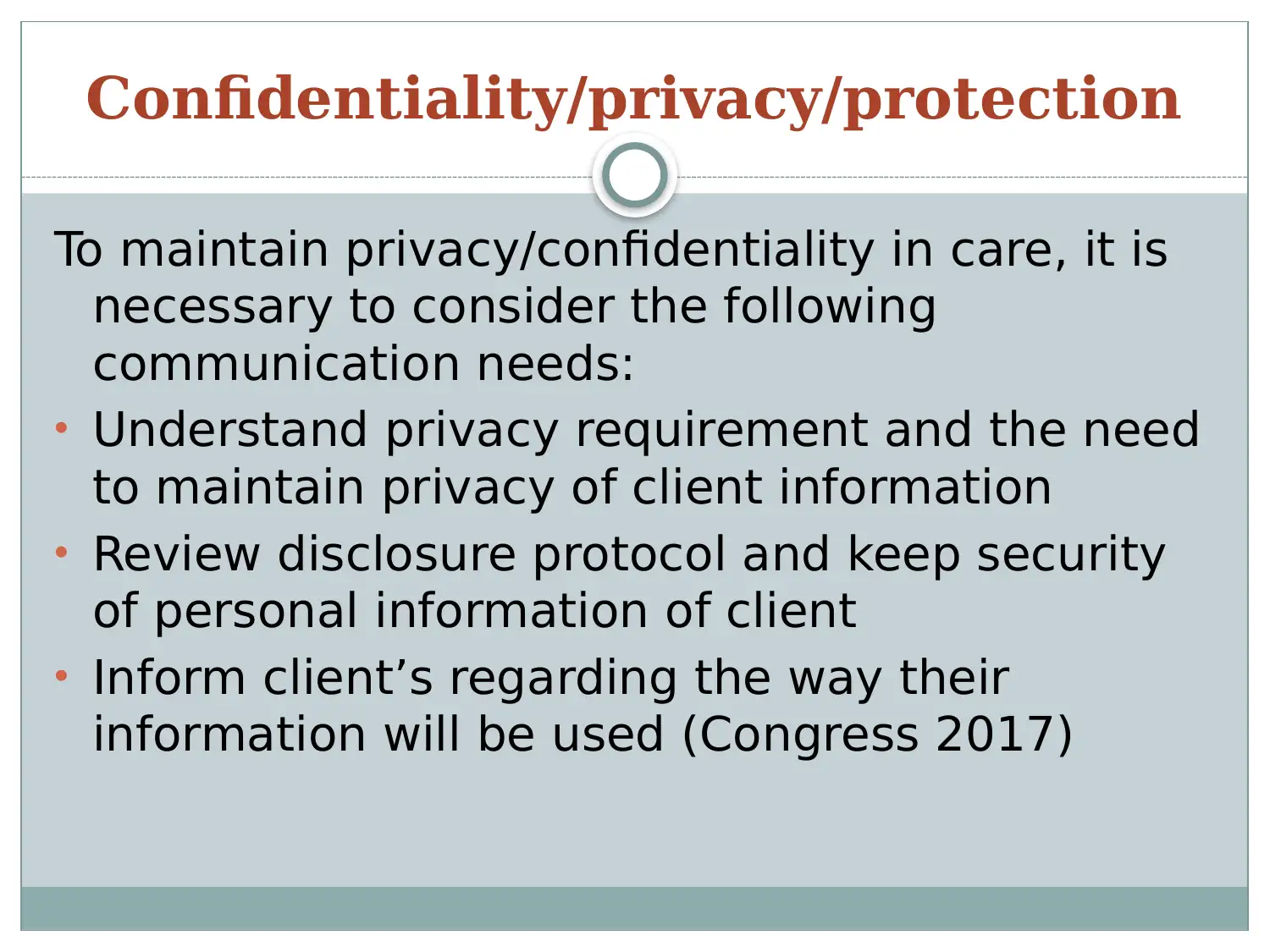
Confidentiality/privacy/protection
To maintain privacy/confidentiality in care, it is
necessary to consider the following
communication needs:
• Understand privacy requirement and the need
to maintain privacy of client information
• Review disclosure protocol and keep security
of personal information of client
• Inform client’s regarding the way their
information will be used (Congress 2017)
To maintain privacy/confidentiality in care, it is
necessary to consider the following
communication needs:
• Understand privacy requirement and the need
to maintain privacy of client information
• Review disclosure protocol and keep security
of personal information of client
• Inform client’s regarding the way their
information will be used (Congress 2017)
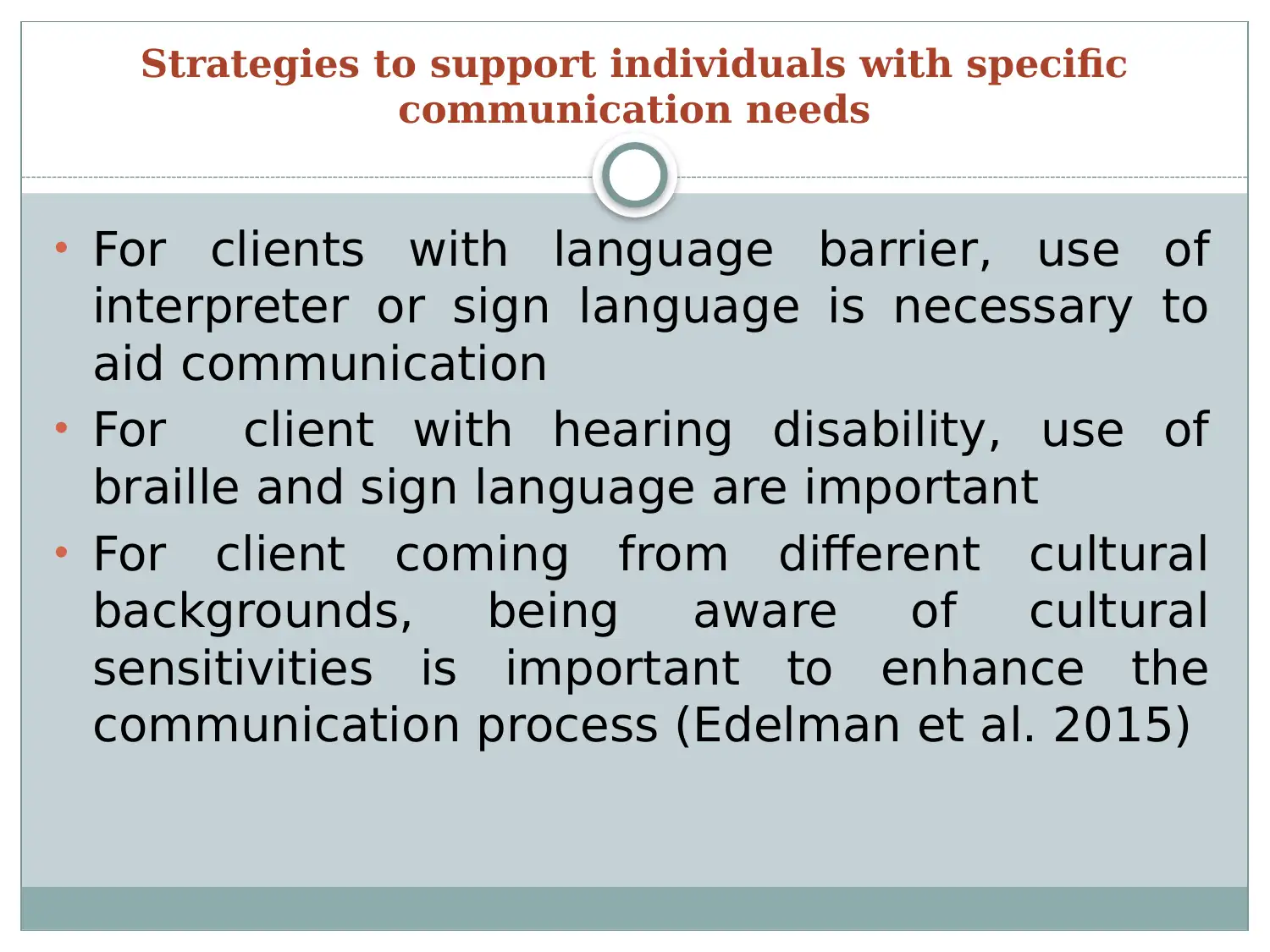
Strategies to support individuals with specific
communication needs
• For clients with language barrier, use of
interpreter or sign language is necessary to
aid communication
• For client with hearing disability, use of
braille and sign language are important
• For client coming from different cultural
backgrounds, being aware of cultural
sensitivities is important to enhance the
communication process (Edelman et al. 2015)
communication needs
• For clients with language barrier, use of
interpreter or sign language is necessary to
aid communication
• For client with hearing disability, use of
braille and sign language are important
• For client coming from different cultural
backgrounds, being aware of cultural
sensitivities is important to enhance the
communication process (Edelman et al. 2015)
Secure Best Marks with AI Grader
Need help grading? Try our AI Grader for instant feedback on your assignments.
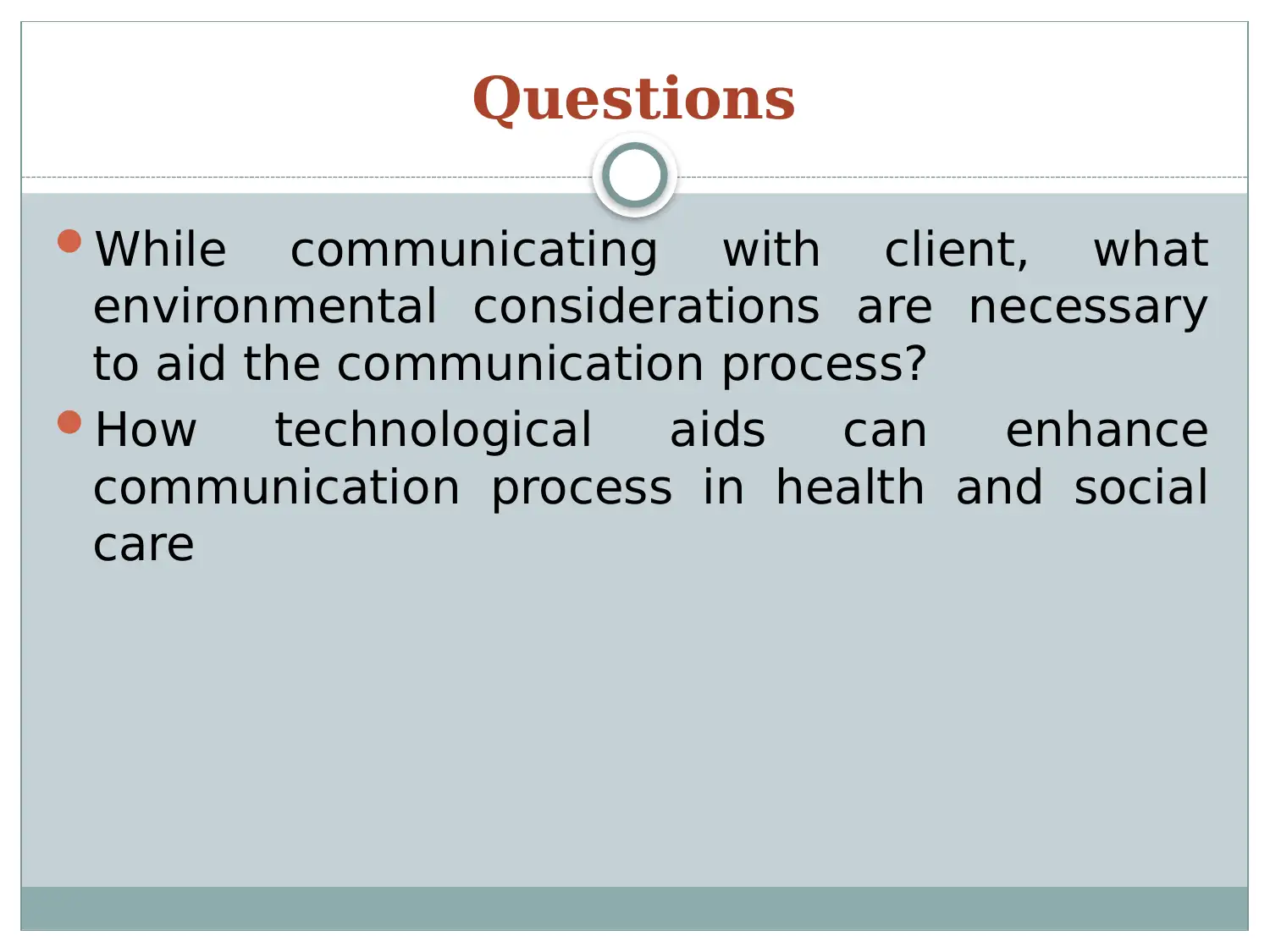
Questions
While communicating with client, what
environmental considerations are necessary
to aid the communication process?
How technological aids can enhance
communication process in health and social
care
While communicating with client, what
environmental considerations are necessary
to aid the communication process?
How technological aids can enhance
communication process in health and social
care
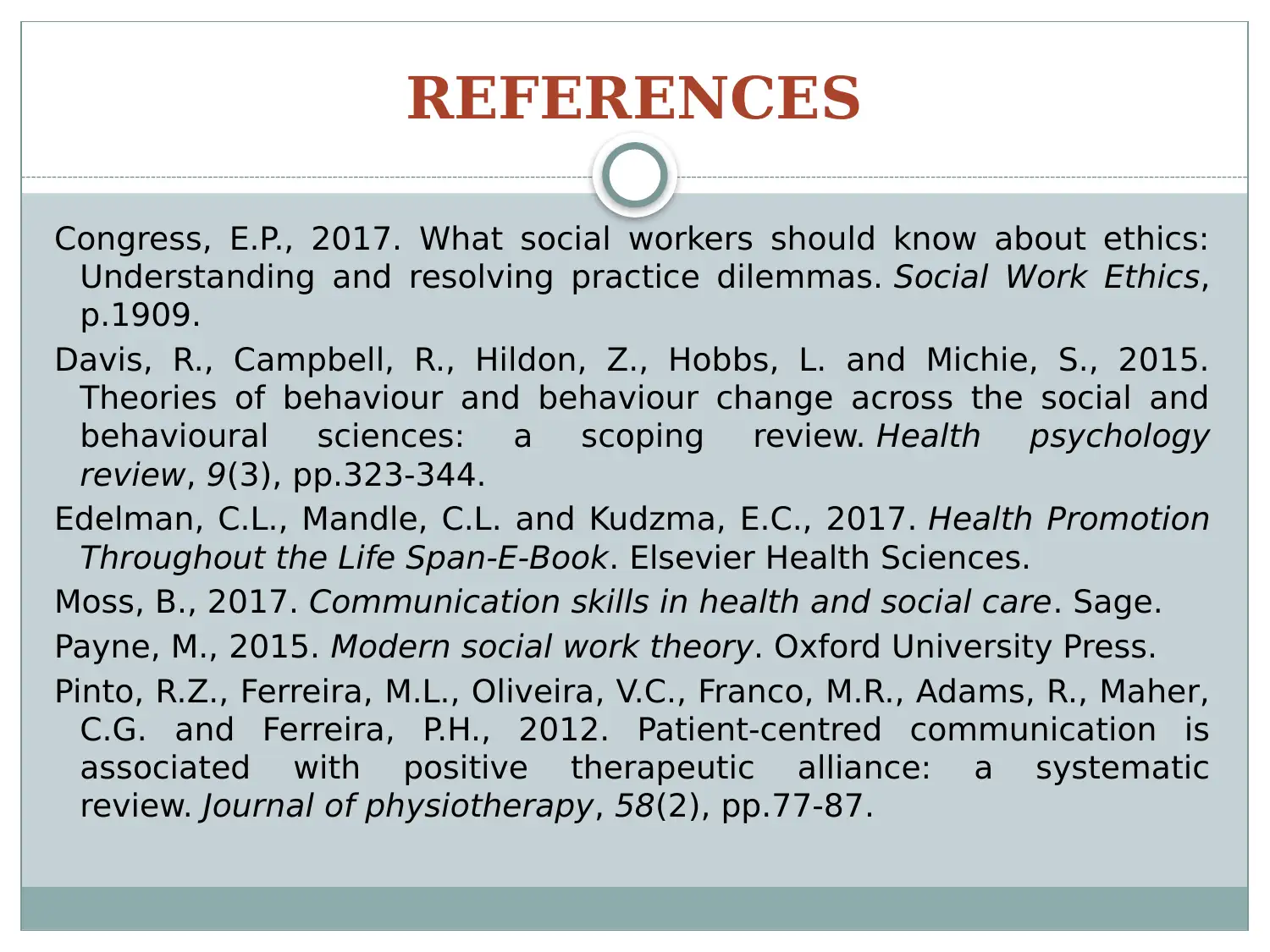
REFERENCES
Congress, E.P., 2017. What social workers should know about ethics:
Understanding and resolving practice dilemmas. Social Work Ethics,
p.1909.
Davis, R., Campbell, R., Hildon, Z., Hobbs, L. and Michie, S., 2015.
Theories of behaviour and behaviour change across the social and
behavioural sciences: a scoping review. Health psychology
review, 9(3), pp.323-344.
Edelman, C.L., Mandle, C.L. and Kudzma, E.C., 2017. Health Promotion
Throughout the Life Span-E-Book. Elsevier Health Sciences.
Moss, B., 2017. Communication skills in health and social care. Sage.
Payne, M., 2015. Modern social work theory. Oxford University Press.
Pinto, R.Z., Ferreira, M.L., Oliveira, V.C., Franco, M.R., Adams, R., Maher,
C.G. and Ferreira, P.H., 2012. Patient-centred communication is
associated with positive therapeutic alliance: a systematic
review. Journal of physiotherapy, 58(2), pp.77-87.
Congress, E.P., 2017. What social workers should know about ethics:
Understanding and resolving practice dilemmas. Social Work Ethics,
p.1909.
Davis, R., Campbell, R., Hildon, Z., Hobbs, L. and Michie, S., 2015.
Theories of behaviour and behaviour change across the social and
behavioural sciences: a scoping review. Health psychology
review, 9(3), pp.323-344.
Edelman, C.L., Mandle, C.L. and Kudzma, E.C., 2017. Health Promotion
Throughout the Life Span-E-Book. Elsevier Health Sciences.
Moss, B., 2017. Communication skills in health and social care. Sage.
Payne, M., 2015. Modern social work theory. Oxford University Press.
Pinto, R.Z., Ferreira, M.L., Oliveira, V.C., Franco, M.R., Adams, R., Maher,
C.G. and Ferreira, P.H., 2012. Patient-centred communication is
associated with positive therapeutic alliance: a systematic
review. Journal of physiotherapy, 58(2), pp.77-87.

1 out of 13
Related Documents
Your All-in-One AI-Powered Toolkit for Academic Success.
+13062052269
info@desklib.com
Available 24*7 on WhatsApp / Email
![[object Object]](/_next/static/media/star-bottom.7253800d.svg)
Unlock your academic potential
© 2024 | Zucol Services PVT LTD | All rights reserved.




